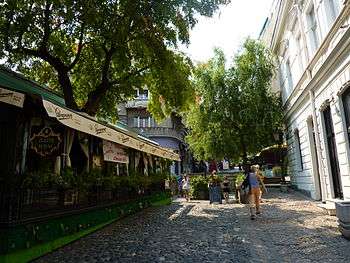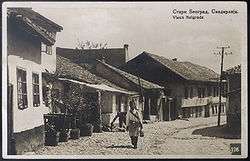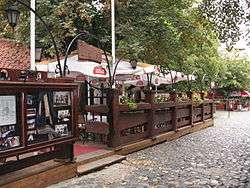Skadarlija

Skadarlija (Serbian Cyrillic: Скадарлија) is a vintage street, an urban neighborhood and former municipality of Belgrade, the capital of Serbia. It is located in the Belgrade municipality of Stari Grad (Old town) and generally considered the main bohemian quarter of Belgrade, similar to Paris' Montmartre.
Location
Skadarlija is located less than 300 metres (330 yd) north-west of Terazije, central Belgrade. It begins right below the Republic Square and stretches along the short, winding Skadarska Street. One of the most famous streets in Belgrade, it is less than 400 metres (440 yd) long. It connects the Despot Stefan Boulevard with the Dušanova Street, near the Bajloni open green market and the Mira Trailović Square, where it extends into the neighborhood of Dorćol.[1]
Administration
Skadarlija became a separate municipality of Belgrade in 1952, after the previous post-World War II division of Belgrade into raions from 1945 to 1952 ended. That municipality included a large portion of urban Belgrade, mainly the Danube oriented neighborhoods[2] like Dorćol, Jalija, Stari Grad, etc. On January 1, 1957 it merged into the new municipality of Stari Grad. Today, Skadarlija forms a "local community" (mesna zajednica), sub-municipal administrative unit, within the municipality of Stari Grad. According to the 2002 census of population, the local community of Skadarlija has 5,942 inhabitants.[3]
History

The history of Skadarlija began in the 1830s with the settlement of Gypsies in the abandoned trenches in front of the ramparts.[4] The 1854 town plan of Belgrade reveals that the Gypsy hovels had been replaced by brick buildings into which artisans, caterers, petty clerks and others moved. The whole locality was referred to as the Gypsy Quarter until 1872, when the street was named after the town of Skadar) (today: Shkodër in Albania). Skadarska ulica, Serbian for "Skadar street", is still the official name.
Skadarlija began to acquire its bohemian character in the last few decades of the 19th century, and particularly after 1901, when the well-known Dardaneli inn was demolished and its guests, prominent writers and actors, moved to the Skadarlija inns or kafanas. The best-known of these were Tri šešira ("Three Hats"), Dva jelena ("Two Deer"), Zlatni bokal ("The Golden Chalice"), Bandist, East, Guild, Vuk Karadžić and The two Sergeants. The first three of these still survive today, accompanied by some new restaurants like Ima dana ("There will be days"), Skadarlija (demolished in 2006), Dva bela goluba ("Two White Doves").
The end section of Skadarlija is known as the Skadarlija atrium. It is mostly occupied by the brewery that belonged to one of the most distinguished Belgrade families before World War II, the Czech-originating Bajloni family. It produced "Aleksandar" beer, made from thermal waters that spring out in the brewery's backyard. The well is located 80 to 300 meters (250 to 1000 feet) under the surface. After 1945, the brewery became part of the "BIP" brewery, but was later closed. The spring water was bottled for drinking until the early 2000s. Under the brewery is a complex of lagums (subterranean galleries or catacombes), which were used as a storage rooms for the beer barrels. As of 2008, the entire inner complex is abandoned and slated for demolition.
The house of Đura Jakšić, a well-known writer and painter who lived and died in Skadarlija, has been turned into a meeting place for the poets participating in the Skadarlija Evenings event. Its renovation and restoration began in 1968 in accordance with the designs made by a group of prominent artists: architect Uglješa Bogunović (1922), writer and painter Zuko Džumhur (1921–89), painter Mario Maskareli (1918–96), sculptor Milica Ribnikar-Bogunović (1931), painter and writer Momo Kapor, among others. They managed to preserve its existing values and introduce modern facilities without interfering with its historical features. In the late 1960s, Skadarlija regained fame as the center of youth and bohemian artists of Belgade.[5] Plans for further adaptations were made in 1977, but remained on paper until 2008.
In 1985 theatre director Zorica Jevremović Munitić founded Children's Street Theater /Ulično dečje pozorište/ in Skadarlija. The core of the troupe was made up of Romany children who lived in Skadarlija, 'white' children' from Dorcol (a nearby prestigious Belgrade neighborhood), Romany children from the favelas of the Belgrade suburb of Mirijevo (who sell flowers in Skadarlija), professional actors and painters who live in Skadarlija, a Skadarlija fortune-teller, clowns, fire eaters, and alternative artists (musicians, painters).
Bohemian life

Well-known but mostly poor poets and writers became regular visitors of Skadarlija in the early 20th century, not just from Serbia but from the wider Yugoslav areas, even before the Yugoslav state was formed as such in 1918. The most prominent residents and visitors in Skadarlija's Bohemian history include Silvana Armenulić,[6] Đura Jakšić, Dobrica Milutinović, Tin Ujević, Gustav Krklec, Stevan Sremac, Antun Gustav Matoš, Zuko Džumhur and Momo Kapor.
My name is Skadarlija...or Skadarska street, however you like it. I am no boulevard...or avenue...or highway. I am common steep curved alley in the middle of Belgrade. And that would be everything meaningful to be told about me if it wouldn't be for my bohemian history, my crumbling roofs, my shaking chairs...— Zuko Džumhur[7]
After decades of performing in Skadarlija's restaurants and outdoors, some singers and performers became synonymous with Skadarlija: singers Šaban Šaulić, Toma Zdravković, Olga Jančevecka, Divna Đokić, Sofka Vasiljković, Mila Matić, actress Ljubica Janićijević who impersonated Gypsy fortune-tellers, and Radomir Šobota as a drummer.[8]
Restaurants are proud of their lists of worldwide celebrities and epicurians who visited them over the decades. Even Alfred Hitchcock ended his diet in Skadarlija . Often, they post photographs of their visits on the walls. For example, over the years, Tri šešira welcomed numerous famous guests such as guitarist Jimi Hendrix, politicians George H.W. Bush, Josip Broz Tito, King Juan Carlos I of Spain, Sandro Pertini, and chess player Anatoly Karpov.
Present

The present Skadarlija, a short and curved street, is a remarkable Belgrade tourist attraction. It includes well-known restaurants, hotels (e.g. Le Petit Piaf), art galleries, antique and souvenir shops, and the Sebilj fountain. Groups playing Serbian brass or traditional urban music and actors dressed in traditional Serb costumes perform down the street. Unlike other similar and popular places in Belgrade that are considered posh, Skadarlija is known as a place visited by young couples and entire families with children. Restaurants offer the typical national cuisine, most notably the roštilj (grilled meat) with pivo (beer). Skadarlija's cafés, restaurants, art exhibits and cobblestone promenade attract up to 20,000 people daily. The street is a car-free zone but it would be unsuited for traffic anyway because it is too narrow and with bumpy cobblestones.
Since 1993, the official opening of the summer season in Skadarlija (restaurants are open the entire year) has been marked by rising a "bohemian flag".[9] The flagpole is located in front of the Zlatni bokal restaurant. The ceremony is always attended by celebrities, including popular and opera singers, actors, and artists.
Future
In February 2008, plans were announced for the complete reconstruction of the lowest section of Skadarlija (Skadarlija atrium, an area of about 1.5 hectares (3.7 acres)) bounded by the streets of Skadarska, Zetska, Cetinjska and Dušanova.[10] Works are scheduled to begin in September 2008 and due to be finished by December 2010. A new multi-functional center will include two hotels, subterranean garage, restaurants, museum and a new pedestrian zone comprising a wide promenade between the Skadarska and Cetinjska streets. The restaurant Stara Skadarlija, two authentic walls of the brewery, the old tower and shopping mall, boiler room and lagums will be preserved but with additional functions. The tower will be illuminated and visible from the city neighborhoods below. The shopping mall's higher floors will be turned into a hotel. Lagums will be open for the public and turned into souvenir and gift shops. The atrium will be turned into a new commercial shopping mall and a hotel with subterranean garage of 1,000 parking spaces. Water springs will be co-opted and protected, and new drills will be added to the existing three springs, as a sort of a tourist attraction. The most controversial aspect at the moment appears to be the concept of a glass box-shaped membrane, lit from the inside, which is supposed to engulf the Stara Skadarlija restaurant. The idea is opposed by the local population.[11] Except for Stara Skadarlija, changes will mainly occur in the side from the Cetinjska street which is considered a low preservation urban area, unlike the Skadarlija side, which is protected by the law and no new construction works will be allowed. As the altitude difference from top to bottom of the projected area is 17 metres (56 ft), it is de facto going to be step-like dug into the ground for almost three floors.
References
- ↑ Beograd - plan i vodič (III ed.). Geokarta. 2007. p. 21. ISBN 978-86-459-0297-2.
- ↑ Mala enciklopedija Prosveta. Vol. II (I ed.). Belgrade: Prosveta Publishing House. 1959. p. 562.
- ↑ "Popis stanovništva po mesnim zajednicama - prvi rezultati" (Press release). Grad Beograd-Zavod za informatiku i statistiku. 2002-07-26.
- ↑ "Skadarlija". www.bg-info.org. 2014. Retrieved 2015-09-12.
- ↑ Mala enciklopedija Prosveta. Vol. III (IV ed.). Belgrade: Prosveta. 1986. p. 400.
- ↑ Newly Composed Folk Music of Yugoslavia; page 74. books.google.com. 2002. Retrieved 2012-12-20.
- ↑ "Duh boemije koji iščezava". Politika (in Serbian). 2008-04-28. p. 39.
- ↑ Skadarlija - duh boemije koji iščezava; RTS documentary on Skadarlija; 2008
- ↑ "Boemski barjak u Skadarskoj ulici". Politika (in Serbian). 2008-04-23. p. 23.
- ↑ "Skadarlija 2010 - novi život boemske četvrti". Politika (in Serbian). 2008-02-20.
- ↑ "Zasijaće Skadarlija". Večernje Novosti (in Serbian). 2008-02-23.
External links
Coordinates: 44°49′04″N 20°27′51″E / 44.8178°N 20.4643°E
| Wikimedia Commons has media related to Skadarlija. |